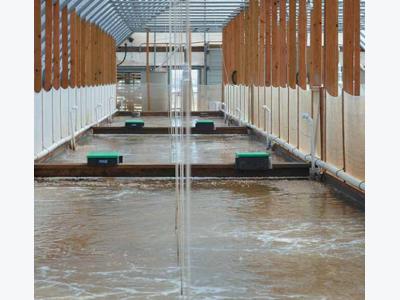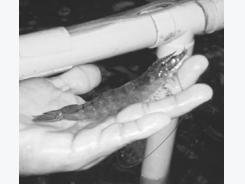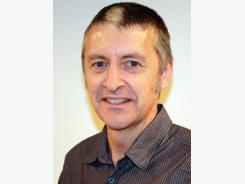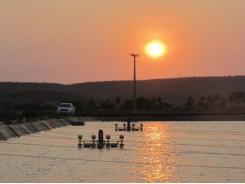Ongoing Studies Advance Intensive Shrimp Culture In Zero-Exchange Biofloc Raceways

Summary: In ongoing trials of greenhouseenclosed intensive biofloc shrimp culture systems, the objectives of a 2012 study were to evaluate the performance of fast-growth shrimp fed a commercial diet formulated for high-density culture systems, and to further evaluate injector performance in the zero-exchange, super-intensive raceways. Although survival was moderate, the production cycle was reduced to 63 days due to sustained weekly growth.
High-efficiency non-Venturi injectors are providing adequate aeration and water mixing in biofloc raceways.
Losses due to viral disease outbreaks and the potential negative impacts of nutrient-rich water on receiving streams are major challenges for the development of sustainable, biosecure and cost-effective shrimp-farming practices. The use of greenhouse-enclosed, super-intensive, biofloc-dominated, zero-exchange systems may alleviate these problems. However, operating biofloc systems at highdensity production levels over 6 kg/m3 requires substantial inputs to satisfy the high oxygen demand of the shrimp and the microbial communities.
Previous Research
Previous studies at the Texas A & M AgriLife Mariculture Lab utilized a pumpdriven Venturi to inject air and/or pure oxygen into a central manifold along raceway bottoms to mix and aerate the water, while additional circulation was provided by airlifts and air diffusers. In an effort to reduce production costs for oxygen supplementation and electricity use, the authors began testing low-maintenance non-Venturi injectors, typically used for wastewater treatment, in 100-m3 biofloc raceways.
According to the manufacturer’s specifications, the injectors provide a 3:1 air:water ratio. In contrast, the Venturi system provides less than a 1:1 ratio and requires the use of supplemental oxygen at high biomass loading to maintain the desired dissolved-oxygen (D.O.) levels.
The 2010 trial in two, 100-m3 raceways resulted in the production of 6.4 kg shrimp/m3 at harvest, while a subsequent 2011 trial resulted in 8.4 kg/m3. In both cases, the injectors provided adequate mixing throughout the water column, eliminating the need for peripheral aeration devices. Although feed-conversion ratios in both of these trials were unusually high – 2.46 and 1.77, respectively – and some oxygen supplementation was provided to determine if increasing D.O. above 5 mg/L would improve performance during the 2011 trial, the authors were confident that performance could be improved in future production trials.
2012 Study
The objectives of the 2012 study were to evaluate the performance of fast-growth shrimp fed a commercial diet formulated for high-density culture systems, and to further evaluate the injector performance in zero-exchange, super-intensive raceways. In addition, primarily through continuous controlled feeding, it was hoped to reduce feed-conversion ratios and feedrelated drops in D.O. levels.

Fast-growth shrimp were harvested using a mechanical harvester after a two-month growout.
Trial Setup
The 63-day growout trial in 2012 was conducted in two, 100-m3 raceways lined with ethylene propylene diene monomer, a synthetic rubber. To provide aeration and mixing, 14 non-Venturi injectors were positioned parallel to the direction of flow along the bottom of each raceway wall. The system could be operated using a single 2-hp pump, or when conditions such as high biomass and solids loading or low dissolved- oxygen levels dictated, two such pumps working concurrently.
To enable the removal of particulate and dissolved organic matter, each raceway had one additional injector to power a homemade foam fractionator, and a simple 2-m3 conical settling tank. The raceways were initially filled with a mixture of seawater (23 m3), municipal chlorinated freshwater (24 m3) and biofloc-rich water (25 m3) from a previous nursery study.
The shrimp used in the study were a cross produced from Taura-resistant and fast-growth genetic lines. Juveniles of 3.60-g weight were stocked at 500 shrimp/m3.
The shrimp were fed a 35%-crude protein diet seven days a week using four belt feeders run continuously in each raceway. On day 7, the raceways were filled to capacity with a mixture of freshwater and saltwater. Initial daily rations were based on an assumed feedconversion ratio of 1:1.4, growth of 1.5 g/week and mortality of 0.5%/week. Rations were later adjusted based on the results of twice-weekly shrimp growth sampling and feed consumption observations.
The raceways were maintained with no water exchange. About 3.32 m3 of freshwater were added weekly to maintain salinity and compensate for water losses associated with operating the foam fractionators and settling tanks. Water temperature, salinity, dissolved oxygen and pH were monitored twice daily. Each raceway was equipped with a dissolved-oxygen monitoring and alarm system. Additional parameters were monitored at regular intervals.
Results
Tables 1 and 2 summarize the daily and weekly water quality indicators. Mean water temperature, salinity, D.O. and pH were 29.60° C, 29.3 ppt, 5.5 mg/L and 7.1, respectively. Total ammonia nitrogen and nitrite nitrogen remained low throughout the study, under 0.6 and 1.5 mg/L, respectively, and nitrate nitrogen levels increased from 67 mg/L at stocking to an average of 309 mg/L at harvest.
Foam fractionators were started on day 8, and the use of the settling tanks began on day 23, when settleable solids reached 23 mL/L in one of the raceways. The flow rate for the foam fractionators was 28.0 L/minute, while in the settling tanks, flows ranged from 8.5 to 20.0 L/minute. Both methods of solids removal were used intermittently.

Water quality parameters were regularly monitored during the study. A monitor/alarm system enhanced dissolved oxygen management.
Mean total suspended solids and settleable solids levels were 292 mg/L and 12 mL/L, respectively (Table 2).
Minor mortality was observed beginning the third week of culture, so supplemental oxygen was provided to alleviate potential stress and stem mortality. The supplemental oxygen had no perceptible effect on mortality, however, and on day 44, when biomass was estimated at about 8.2 kg shrimp/m3, the second 2-hp pump was engaged to increase aeration. Oxygen supplementation was discontinued three days later.
On day 64, shrimp were harvested using a mechanical harvester. Reaching a mean final weight of 22.72 g, the shrimp grew an average of 2.12 g/week and yielded an average of 903 kg/100-m3 raceway (Table 3). At 79.5%, survival was moderate. However, mean production levels in the 2012 study were higher than 2011 – 9.03 versus 8.4 kg/m3 – and the feed-conversion ratio was reduced from 1.77 to 1.48.
Perspectives
The injectors were able to maintain adequate D.O. levels and mixing for the production of marketable size shrimp in a biofloc-dominated system with a substantial biomass load above 9 kg/m3, maintaining D.O. in the raceways at 83 to 86% saturation in most cases. Although supplemental oxygen was eventually deemed unnecessary in the study, supplementation was reduced by about 15% from 2011 levels despite higher biomass. Continuous feeding seems to have eliminated the low-D.O. events observed following hand feeding in the past and may have contributed to improved feed conversion.
The major development of the 2012 study was the reduction of the production cycle from 106 days in 2011 to 63 days due to sustained weekly growth of greater than 2 g. Clearly, the use of shrimp from a fast-growth genetic line can significantly increase the number of potential crops per year and make enclosed biofloc systems more economically viable.
Table 1. Mean daily water quality parameters during a 63-day growout study with juvenile L. vannamei in aerated raceways.
| Mean (± S.D) | Range | ||
| Temperature (º C) | a.m. | 29.34 ± 0.48 | 28.16-30.65 |
| p.m. | 29.81 ± 0.54 | 28.38-31.07 | |
| Salinity (ppt) | a.m. | 29.27 ± 2.70 | 25.43-34.70 |
| p.m. | 29.18 ± 2.71 | 25.95-34.81 | |
| Dissolved oxygen (mg/L) | a.m. | 5.65 ± 0.41 | 4.92-6.77 |
| p.m. | 5.43 ± 0.37 | 4.40-6.33 | |
| pH | a.m. | 7.07 ± 0.22 | 6.54-7.40 |
| p.m. | 7.12 ± 0.24 | 6.25-7.47 |
Table 2. Mean weekly water quality parameters during a 63-day growout study with juvenile L. vannamei in aerated raceways.
| Mean (± S.D) | Range | |
| Five-day biological oxygen demand (mg/L) | 48.0 ± 16.9 | 28.3-87.2 |
| Alkalinity (mg/L) | 170.8 ± 17.7 | 120.0-201.4 |
| Total suspended solids (mg/L) | 292.4 ± 75.5 | 137.5-475.0 |
| Settleable solids (mL/L) | 12.2 ± 3.5 1 | 2.0-23.0 |
| Volatile suspended solids (mg/L) | 193.4 ± 38.6 | 127.5-258.3 |
| Turbidity (NTU) | 116.2 ± 42.1 | 58.3-218.0 |
| Total ammonia nitrogen (mg/L) | 0.30 ± 0.14 | 0.15-0.59 |
| Nitrite nitrogen (mg/L) | 0.36 ± 0.29 | 0.10-1.45 |
| Nitrate nitrogen (mg/L) | 172.4 ± 91.7 | 46.7-364.7 |
Table 3. Shrimp performance following a 63-day growout study with juvenile L. vannamei in aerated raceways.
| Raceway | Stocking (shrimp/m3) | Stocking Weight (g) | Harvest Weight (g) | Weekly Growth (g) | Survival (%) | Yield (kg/m3) | Feed-Conversion Ratio | Water Use (L/kg) |
| 1 | 500 | 3.60 | 22.76 | 2.13 | 80.82 | 9.20 | 1.43 | 139.5 |
| 2 | 500 | 3.60 | 22.67 | 2.12 | 78.19 | 8.86 | 1.53 | 148.9 |
| Average | 22.72 | 2.12 | 79.50 | 9.03 | 1.48 | 144.2 | ||
Authors:
Tzachi M. Samocha, Ph.D. - Texas A & M AgriLife Research 4301 Waldron Road Corpus Christi, Texas 78418 USA t-samocha@tamu.edu
André Braga - Vita Magalhães Marine Station of Aquaculture Oceanography Institute Federal University of Rio Grande Brazil
Bob Advent - a3 All Aqua Aeration Orlando, Florida, USA
Timothy C. Morris - Texas A & M AgriLife Research
Related news
Tools

Phối trộn thức ăn chăn nuôi

Pha dung dịch thủy canh

Định mức cho tôm ăn

Phối trộn phân bón NPK

Xác định tỷ lệ tôm sống

Chuyển đổi đơn vị phân bón

Xác định công suất sục khí

Chuyển đổi đơn vị tôm

Tính diện tích nhà kính

Tính thể tích ao




 New technology proves effective for EMS-hit shrimp farmer
New technology proves effective for EMS-hit shrimp farmer  The importance of dissolved oxygen in Pacific White…
The importance of dissolved oxygen in Pacific White…